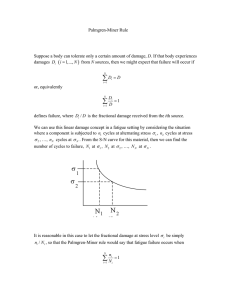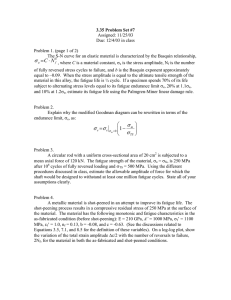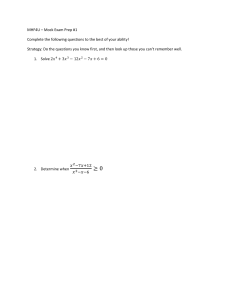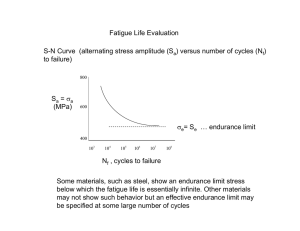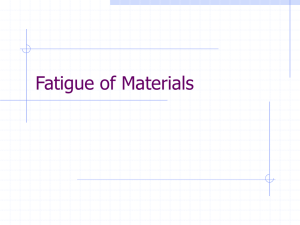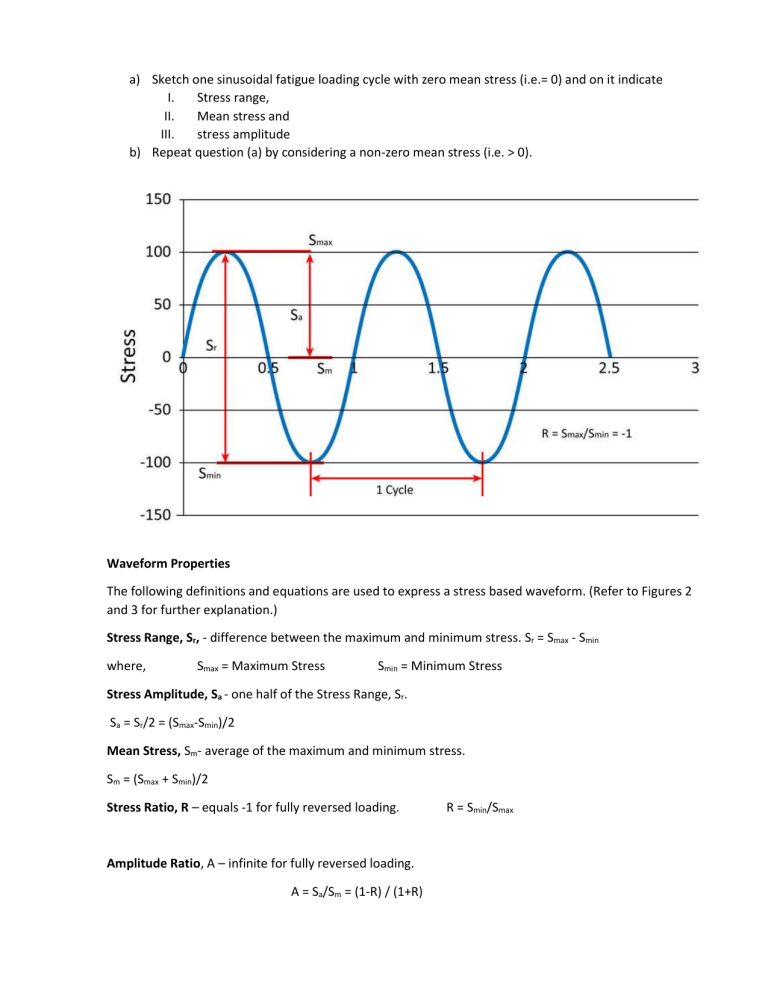
a) Sketch one sinusoidal fatigue loading cycle with zero mean stress (i.e.= 0) and on it indicate I. Stress range, II. Mean stress and III. stress amplitude b) Repeat question (a) by considering a non-zero mean stress (i.e. > 0). Waveform Properties The following definitions and equations are used to express a stress based waveform. (Refer to Figures 2 and 3 for further explanation.) Stress Range, Sr, - difference between the maximum and minimum stress. Sr = Smax - Smin where, Smax = Maximum Stress Smin = Minimum Stress Stress Amplitude, Sa - one half of the Stress Range, Sr. Sa = Sr/2 = (Smax-Smin)/2 Mean Stress, Sm- average of the maximum and minimum stress. Sm = (Smax + Smin)/2 Stress Ratio, R – equals -1 for fully reversed loading. Amplitude Ratio, A – infinite for fully reversed loading. A = Sa/Sm = (1-R) / (1+R) R = Smin/Smax The S-N or Wohler Diagram In stress based fatigue tests, multiple samples of identical size, shape and composition are subjected to different levels of stress amplitude, Sa, or stress range, Sr, and the number of cycles to failure, N, is measured for each. Various types of instruments and machines are used to apply cyclic loading and include rotating bend and cantilever bend machines (Figure 7), servo-hydraulic or servo-electric axial push-pull testing systems (Figure 8), and electric motor driven torsion fatigue testers (Figure 9). The resulting S-N data for each identical specimen is plotted on either a log-log or semi log graph. Regression is used to fit a curve through the points resulting in an S-N diagram as shown in Figure 6. Depending on the type of cyclic loading the ordinate (y-axis) will represent stress amplitude, Sa, stress range, Sr, or maximum stress, Smax. 7 8 9 The S-N diagram for some materials including steel and titanium transitions to a zero slope at a particular stress level. As shown in Figure 6, the point at which the slope transitions to zero is referred to as the endurance limit. Materials subjected to stresses below the endurance limit will never fail under cyclic loading. The portion of the curve with negative slope is defined as the finite life region and the horizontal or zero slope portion of the curve is the infinite life region. Many non-ferrous alloys such as aluminum and copper and composites such as fiber reinforced plastic exhibit an S-N diagram with negative slope only. Negative slope S-N diagrams have no definite endurance limit (see the aluminum S-N diagram in Figure 6). Materials exhibiting S-N diagrams without a definite endurance limit, report fatigue strength as a stress below which failure will not be expected in less than a specified number of cycles. The fatigue strength or effective endurance limit for these materials is sometimes defined as the stress that causes failure at a specified number of cycles (i.e. 108). S N CURVE :ANALYSIS,PLOTTING & SIGNIFICANCE By BADHUL B PILLAI March 9, 2021 S N CURVE : INTRODUCTION S-N CURVE : It implies a plot drawn between Stress Amplitude (Sf) and No. of stress cycles (N). This curve basically plotted by identifying stress points and no. of cycle points at various intervals during rotation of shaft. Total interval usually taken from Central plane (i.e 00) to one full rotation (i.e 3600). Also, it implies one stress cycle completed by the specimen. PLOTTING AND ITS RELATED TERMINOLOGIES : Usually, in the FATIGUE TESTING MACHINE EXPERIMENT, the stress amplitude and no. of stress cycles taken and noted down until the appearance of first fatigue crack. And, these values plotted in the 2D along a rectangular coordinate plane. All these points when joined together gives a curve, called S N CURVE. FOR THE CURVE : X AXIS = NO. OF STRESS CYCLES (N) = log10N Y AXIS = STRESS AMPLITUDE (Sf) = log10Sf The graph system used is a LOG-LOG GRAPHICAL SYSTEM so that higher values of x and y can be plotted easily on a copy. TERMS : 1) Sf= Stress Amplitude for a particular fatigue life (N) 2) Se= Endurance limit ( Max. Stress Amplitude for 106 cycles) 3) N= Fatigue life/Life of a component for a particular stress amplitude (Sf) S N CURVE CHARACTERISTICS FOR FERROUS AND NON – FERROUS MATERIALS : FERROUS MATERIALS : For ferrous materials like Steel, the S N Curve becomes asymptotic at 106 cycles. This point indicates the magnitude of stress amplitude corresponding to infinite no. of stress cycles. This stress amplitude indicates the ENDURANCE STRENGTH of the component ( i.e at 106 cycles). NON FERROUS MATERIALS : For non ferrous materials like Aluminium, the S N Curve gradually slopes over even after 106 cycles. So, Endurance Limit values are not distinct in these cases . For these materials , the Endurance limit stress usually represented as a function of No. of stress cycles. Se= f(N) TYPES OF S N CURVE FATIGUE LEVELS : 1) LOW CYCLE FATIGUE LEVELS: Any fatigue failure which has No.of stress cycles less than 103 (i.e N<103 or log10N<3). Failure of studs on truck wheels, failure of setscrews for locating gears on shafts etc. shows some examples of this level of failure. The design criteria for this fatigue level is always taken on the basis of Ultimate tensile strength and yield strength with suitable FOS. 2) HIGH CYCLE FATIGUE LEVELS: Any fatigue failure which has No.of stress cycles more than 103 (i.e N>103 or log10N>3). Failure of machine components such as springs ,ball bearings or gears with fluctuating stresses etc. shows some examples of this level of failure. The design criteria for this fatigue level is usually taken on the basis of endurance limit stress. S N CURVE and many other theories are used in the design analysis. These theories will be discussed in the upcoming blogs.

